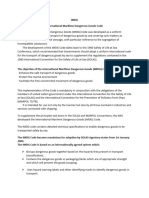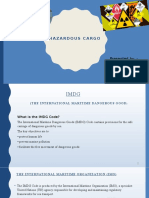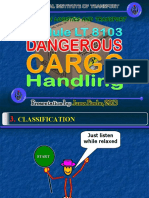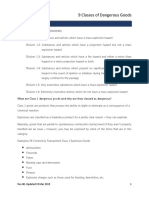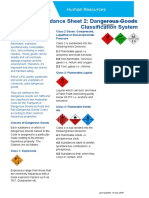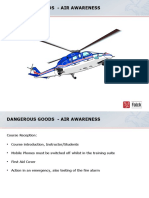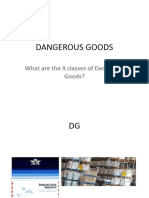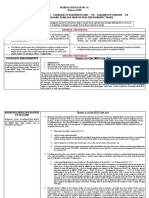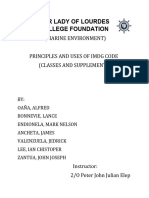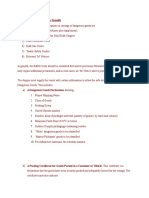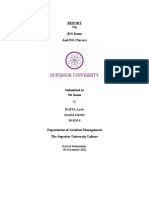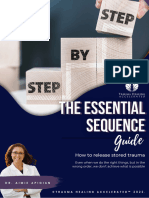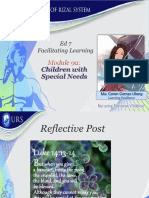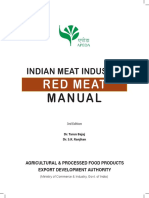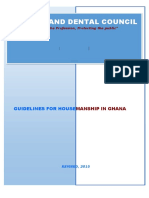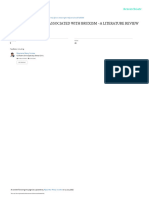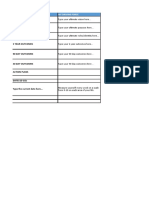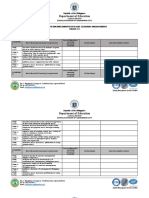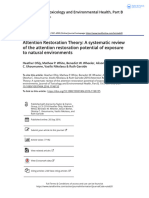ENGG*1070
Occupational Health and Safety
Lecture 12
Fall 2023
1
�2
�• Why need to label goods
• Labeling package of a dangerous goods during
transportation is important.
• Labels use often to illustrate the hazards associated
with the goods, and ensuring the shipment is safely
handled and prevented any spills, accidents and
exposure.
3
�• Classes of Dangerous Goods
Class 1: Explosives
Explosives, as included in the Explosives Act,
4
�• Classes of Dangerous Goods
Class 2: Gases
Compressed, deeply refrigerated, liquefied or dissolved under
Pressure,
5
�• Classes of Dangerous Goods
Class 2: Gases
Compressed, deeply refrigerated, liquefied or dissolved under
Pressure,
6
�• Classes of Dangerous Goods
Class 3: Flammable Liquids
A liquid which has a closed-cup flash point not greater than
60Co ,
7
�• Classes of Dangerous Goods
Class 4: Flammable Solids
Flammable solids, meaning substances liable to spontaneous
combustion, and substances that emit flammable gases upon
contact with water,
8
�• Classes of Dangerous Goods
Class 5: Oxidizing Substances and Organic Peroxides
Substance which causes or contributes to the combustion of other
material by yielding oxygen or other oxidizing substances or organic
compounds which are strong oxidizing agents and may be liable to
explosive decomposition, be sensitive to heat, shock or friction or
react dangerously with other dangerous goods,
9
�• Classes of Dangerous Goods
Class 6: Toxic and Infectious Substances
A solid or liquid that is toxic through inhalation, by skin contact
or by ingestion or Micro-organisms that are infectious or that
are reasonably believed to be infectious to humans or Animals,
10
�• Classes of Dangerous Goods
Class 7: Radioactive Materials
Nuclear substances, within the meaning of the Nuclear Safety
and Control Act, which are radioactive,
11
�• Classes of Dangerous Goods
Class 8: Corrosives
A substance that causes destruction of skin or corrodes steel or
non-clad aluminum,
12
�• Classes of Dangerous Goods
Class 9: Miscellaneous Products, Substances or
Organisms
Miscellaneous products, substances or organisms considered by
the Governor-in-Council to be dangerous to life, health,
property or the environment when handled, offered for
transport or transported,
Examples:
Ammonium nitrate based fertilizer.
Asbestos
Automobile airbags
Lithium batteries
13
�• Other Marks
14
�• Consignor Responsibilities
The consignor must:
• Display or ensure the display of the required dangerous
goods safety marks on each large or small means of
containment that contains the dangerous goods.
• Provide to the carrier the dangerous goods safety marks for
the dangerous goods that the consignor is offering for
transport or importing and that are to be transported in a large
means of containment.
15
�• Carrier Responsibilities
The carrier of dangerous goods must:
• Ensure that the required dangerous goods safety marks
remain displayed on the small means of containment while the
dangerous goods are in transport.
• Display the required dangerous goods safety marks on the
large means of containment, unless they are already displayed
on it.
16
�•
17
�• Case Study
18
�• Pipelines
Transportation Safety Board Regulations (SOR/2014-37)
• Pipeline Operators
• Pipeline Construction
• Pipeline Service
• Pipeline Equipment Manufacturers
19
�•
20
�• References:
Source : https://www.mountainone.com/news/does-your-new-car-have-spare-tire-dont-count-it
21




